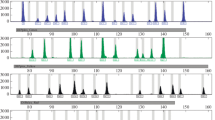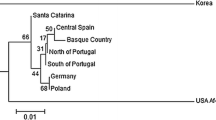Abstract
The migratory phenomenon in Portugal has become one of the main factors for the genetic variability. In the last few years, a new class of autosomal insertion/deletion markers—InDel—has attracted interest in forensic genetics. Since there is no data for InDel markers of Portuguese-speaking African countries (PALOP) immigrants living in Lisboa, our aim is the characterization of those groups of individuals by typing them with at least 30 InDel markers and to compare different groups of individuals/populations. We studied 454 bloodstain samples belonging to immigrant individuals from Angola, Guinea-Bissau, and Mozambique. DNA extraction was performed with the Chelex® 100 method. After extraction, all samples were typed with the Investigator® DIPplex method. Through the obtained results, allelic frequencies show that all markers are at Hardy-Weinberg equilibrium, and we can confirm that those populations show significant genetic distances between themselves, between them, and the host Lisboa population. Because of this, they introduce genetic variability in Lisboa population.

Similar content being viewed by others
References
Morais P, Amorim A, Vieira da Silva C, Ribeiro T, Costa Santos J, Afonso Costa H (2015) Genetic portrait of Lisboa immigrant population from Cabo Verde with mitochondrial DNA analysis. J Genet 94(3):509–512
Simão F, Afonso Costa H, Vieira da Silva C, Ribeiro T, Porto MJ, Costa Santos J, Amorim A (2014) Genetic portrait of Lisboa immigrant population from Angola with mitochondrial DNA. Forensic Sci Int Genet 15:33–38. doi:10.1016/j.fsigen.2014.09.013
Afonso Costa H, Morais P, Vieira da Silva C, Matos S, Marques Santos R, Espinheira R, Costa Santos J, Amorim A (2014) X-Chromosome STR markers data in a Cabo Verde immigrant population of Lisboa. Mol Biol Rep 41:2559–2569. doi:10.1007/s11033-014-3114-9
Marques dos Santos R, Vieira da Silva C, Afonso Costa H, Ferreira Gomes P, Sanches S, Espinheira R, Costa Santos J, Amorim A (2012) Genetic portrait of an immigrant population from Angola living in Lisboa. Forensic Sci Int Genet 6:170–173. doi:10.1016/j.fsigen.2012.05.010
Amorim A, Marques dos Santos R, Vieira da Silva C, Afonso Costa H, Espinheira R, Ferreira Gomes P, Costa Santos J (2012) Genetic portrait of a native population of Cabo Verde living in Lisboa. Forensic Sci Int Genet 6:166–169. doi:10.1016/j.fsigen.2012.05.006
Amorim A, Marques dos Santos R, Vieira da Silva C, Afonso Costa H, Espinheira R, Costa Santos J (2012) Genetic portrait of Brazilian immigrant population living in Lisboa. Forensic Sci Int Genet 6:121–124. doi:10.1016/j.fsigen.2012.01.008
Amorim A, Vieira da Silva C, Afonso Costa H, Sanches S, Espinheira R, Costa Santos J (2011) Allele frequencies of all CODIS and four non-CODIS STR loci of an immigrant Brazilian population living in Lisbon—preliminary results. Forensic Sci Int Genet Suppl Ser 3:127–128. doi:10.1016/j.fsigss.2011.08.063
Carvalho A, Pinheiro MF (2013) Population data of 30 insertion/delection polymorphisms from a sample taken in the North of Portugal. Int J Legal Med 127:65–67. doi:10.1007/s00414-012-0693-7
Meng H-T, Zhang Y-D, Shen C-M, Yuan G-L, Yang C-H, Jin R, Yan J-W, Wang H-D, Liu W-J, Jing H, Zhu B-F (2015) Genetic polymorphism analyses of 30 InDels in Chinese Xibe ethnic group and its population genetic differentiations with other groups. Sci Rep 5:8260. doi:10.1038/srep08260
LaRue BL, Lagacé R, Chang CW, Holt A, Hennessy L, Ge J, King JL, Chakraborty R, Budowle B (2014) Characterization of 114 insertion/deletion (INDEL) polymorphisms, and selection for a global INDEL panel for human identification. Leg Med 16:26–32. doi:10.1016/j.legalmed.2013.10.006
Zidkova A, Horinek A, Kebrdlova V, Korabecna M (2013) Application of the new insertion-deletion polymorphism kit for forensic identification and parentage testing on the Czech population. Int J Legal Med 127:7–10. doi:10.1007/s00414-011-0649-3
Pepinski W, Abreu-Glowacka M, Koralewska-Kordel M, Michalak E, Kordel K, Niemcunowicz-Janica A, Szeremeta M, Konarzewska M (2013) Population genetics of 30 INDELs in populations of Poland and Taiwan. Mol Biol Rep 40:4333–4338. doi:10.1007/s11033-013-2521-7
Pereira R, Phillips C, Pinto N, Santos C, dos Santos SEB, Amorim A, Carracedo Á, Gusmão L (2012) Straightforward inference of ancestry and admixture proportions through ancestry-informative insertion deletion multiplexing. PLoS One 7:1–10. doi:10.1371/journal.pone.0029684
Klein R, Neumann C, Roy R (2015) Detection of insertion/deletion polymorphisms from challenged samples using the Investigator DIPplex® Kit. Forensic Sci Int Genet 16:29–37. doi:10.1016/j.fsigen.2014.11.020
Mills RE, Luttig CT, Larkins CE, Beauchamp A, Tsui C, Pittard WS, Devine SE (2006) An initial map of insertion and deletion (INDEL) variation in the human genome. Genome Res 16:1182–1190. doi:10.1101/gr.4565806
Ferreira Palha TDJB, Ribeiro Rodrigues EM, Cavalcante GC, Marrero A, de Souza IR, Seki Uehara CJ, Silveira da Motta CHA, Koshikene D, da Silva DA, de Carvalho EF, Chemale G, Freitas JM, Alexandre L, Paranaiba RTF, Soler MP, Santos S (2015) Population genetic analysis of insertion–deletion polymorphisms in a Brazilian population using the Investigator DIPplex kit. Forensic Sci Int Genet 19:10–14. doi:10.1016/j.fsigen.2015.03.015
Seong KM, Park JH, Hyun YS, Kang PW, Choi DH, Han MS, Park KW, Chung KW (2014) Population genetics of insertion-deletion polymorphisms in South Koreans using Investigator DIPplex kit. Forensic Sci Int Genet 8:80–83. doi:10.1016/j.fsigen.2013.06.013
LaRue BL, Ge J, King JL, Budowle B (2012) A validation study of the Qiagen Investigator DIPplex® kit: an INDEL-based assay for human identification. Int J Legal Med 126:533–540. doi:10.1007/s00414-012-0667-9
Li CT, Zhang SH, Zhao SM (2011) Genetic analysis of 30 InDel markers for forensic use in five different Chinese populations. Genet Mol Res 10:964–979. doi:10.4238/vol10-2gmr1082
Neuvonen AM, Palo JU, Hedman M, Sajantila A (2012) Discrimination power of Investigator DIPplex loci in Finnish and Somali populations. Forensic Sci Int Genet 6:99–102. doi:10.1016/j.fsigen.2011.09.005
Wei YL, Qin CJ, Dong H, Jia J, Li CX (2014) A validation study of a multiplex INDEL assay for forensic use in four Chinese populations. Forensic Sci Int Genet 9:e22–e25. doi:10.1016/j.fsigen.2013.09.002
Friis SL, Børsting C, Rockenbauer E, Poulsen L, Fredslund SF, Tomas C, Morling N (2012) Typing of 30 insertion/deletions in Danes using the first commercial indel kit - Mentype® DIPplex. Forensic Sci Int Genet 6:72–74. doi:10.1016/j.fsigen.2011.08.002
Kis Z, Zalán A, Volgyi A, Kozma Z, Domján L, Pamjav H (2012) Genome deletion and insertion polymorphisms (DIPs) in the Hungarian population. Forensic Sci Int Genet 6:125–126
Tomas C, Skitsa I, Steinmeier E, Poulsen L, Ampati A, Børsting C, Morling N (2015) Results for five sets of forensic genetic markers studied in a Greek population sample. Forensic Sci Int Genet 16:132–137. doi:10.1016/j.fsigen.2015.01.001
Walsh P, Metzger D, Higuchi R (1991) Chelex 100 as a médium for simple extraction of DNA for PCR-based typing from forensic material. Biotechniques 10:506–513
Excoffier L, Laval G, Schneider S (2005) Arlequin (version 3.0): an integrated software package for population genetics data analysis. Evol Bioinform Online 1:47–50
Armstrong RA (2014) When to use the bonferroni correction. Ophthalmic Physiol Opt 34:502–508. doi:10.1111/opo.12131
Vieira da Silva C, Matos S, Afonso Costa H, Morais P, Dos Santos RM, Espinheira R, Costa Santos J, Amorim A (2013) Genetic portrait of south Portugal population with InDel markers. Forensic Sci Int Genet 7:10–12. doi:10.1016/j.fsigen.2013.03.009
Reis RA, InDel e SNP (2014) Caracterização Genética das Populações Imigrantes de Cabo Verde e Guiné-Bissau a residir na Região de Lisboa, Escola Superior de Saúde Egas Moniz
Felsenstein J (1989) PHYLIP—Phylogeny Inference Package (Version 3.2). Cladistics 5:164–166
Pereira L, Gusmão L, Alves C, Amorim A, Prata MJ (2002) Bantu and European Y-lineages in Sub-Saharan Africa. Ann Hum Genet 66:369–378
Carracedo A, Butler JM, Gusmão L, Linacre A, Parson W, Roewer L, Schneider PM (2014) Update of guidelines for the publication of genetic population data. Forensic Sci Int Genet 10:A1–A2
Author information
Authors and Affiliations
Corresponding author
Rights and permissions
About this article
Cite this article
Inácio, A., Costa, H.A., da Silva, C.V. et al. Study of InDel genetic markers with forensic and ancestry informative interest in PALOP’s immigrant populations in Lisboa. Int J Legal Med 131, 657–660 (2017). https://doi.org/10.1007/s00414-016-1484-3
Received:
Accepted:
Published:
Issue Date:
DOI: https://doi.org/10.1007/s00414-016-1484-3




